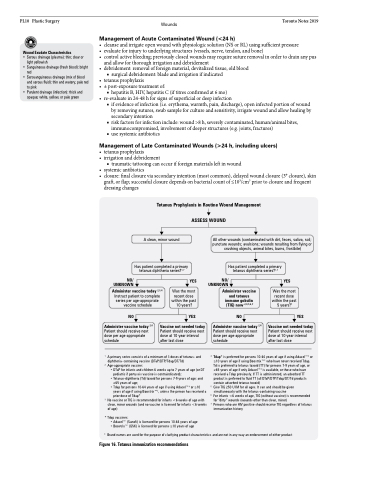Page 1132 - TNFlipTest
P. 1132
PL10 Plastic Surgery
Wounds Toronto Notes 2019
Management of Acute Contaminated Wound (<24 h)
• cleanseandirrigateopenwoundwithphysiologicsolution(NSorRL)usingsufficientpressure
• evaluateforinjurytounderlyingstructures(vessels,nerve,tendon,andbone)
• control active bleeding; previously closed wounds may require suture removal in order to drain any pus
and allow for thorough irrigation and debridement
• debridement:removalofforeignmaterial,devitalizedtissue,oldblood
■ surgical debridement: blade and irrigation if indicated • tetanusprophylaxis
• ± post-exposure treatment of:
■ hepatitis B, HIV, hepatitis C (if titres confirmed at 6 mo)
• re-evaluatein24-48hforsignsofsuperficialordeepinfection
■ if evidence of infection (i.e. erythema, warmth, pain, discharge), open infected portion of wound by removing sutures, swab sample for culture and sensitivity, irrigate wound and allow healing by secondary intention
■ risk factors for infection include: wound >8 h, severely contaminated, human/animal bites, immunocompromised, involvement of deeper structures (e.g. joints, fractures)
■ use systemic antibiotics
Management of Late Contaminated Wounds (>24 h, including ulcers)
• tetanusprophylaxis
• irrigationanddebridement
■ traumatic tattooing can occur if foreign materials left in wound
• systemicantibiotics
• closure:finalclosureviasecondaryintention(mostcommon),delayedwoundclosure(3°closure),skin
graft, or flap; successful closure depends on bacterial count of ≤105/cm3 prior to closure and frequent dressing changes
Wound Exudate Characteristics
• Serous drainage (plasma): thin; clear or light yellowish
• Sanguineous drainage (fresh blood): bright red
• Serosanguineous drainage (mix of blood and serous fluid): thin and watery; pale red to pink
• Purulent drainage (infection): thick and opaque; white, yellow, or pale green
Tetanus Prophylaxis in Routine Wound Management
ASSESS WOUND
A clean, minor wound
Has patient completed a primary tetanus diphtheria series?1,7
All other wounds (contaminated with dirt, feces, saliva, soil; puncture wounds; avulsions; wounds resulting from flying or crushing objects, animal bites, burns, frostbite)
YES
Was the most recent dose within the past 10 years?
YES
Vaccine not needed today
Patient should receive next dose at 10 year interval after last dose
YES
Was the most recent dose within the past 5 years?7
YES
Vaccine not needed today
Patient should receive next dose at 10 year interval after last dose
Has patient completed a primary tetanus diphtheria series?1,7
NO/ UNKNOWN
Administer vaccine today 2,3,4
Instruct patient to complete series per age-appropriate vaccine schedule
NO Administer vaccine today 2,4
Patient should receive next dose per age-appropriate schedule
NO/ UNKNOWN
Administer vaccine
and tetanus
immune gobulin (TIG) now 2,4,5,6,7
NO Administer vaccine today 2,4
Patient should receive next dose per age-appropriate schedule
1 A primary series consists of a minimum of 3 doses of tetanus- and diphtheria- containing vaccine (DTaP/DTP/Tdap/DT/Td)
2 Age-appropriate vaccine:
• DTaP for infants and children 6 weeks up to 7 years of age (or DT
pediatric if pertussis vaccine is contraindicated);
• Tetanus-diphtheria (Td) toxoid for persons 7-9 years of age; and
≥65 years of age;
• Tdap for persons 10-64 years of age if using AdacelTM‡ or ≥10
years of age if using BoostrixTM‡, unless the person has received a
prior dose of Tdap*
3 No vaccine or TIG is recommended for infants <6 weeks of age with
clean, minor wounds (and no vaccine is licensed for infants <6 weeks of age)
* Tdap vaccines:
• AdacelTM (Sanofi) is licensed for persons 10-64 years of age • BoostrixTM (GSK) is licensed for persons ≥10 years of age
4 Tdap* is preferred for persons 10-64 years of age if using AdacelTM‡ or ≥10 years of age if using BoostrixTM‡ who have never received Tdap. Td is preferred to tetanus toxoid (TT) for persons 7-9 years of age, or ≥65 years of age if only AdacelTM‡ is available, or those who have received a Tdap previously. If TT is administered, an adsorbed TT product is preferred to fluid TT (all DTaP/DTP/Tdap/DT/Td products contain adsorbed tetanus toxoid)
5 Give TIG 250 U IM for all ages. It can and should be given simultaneously with the tetanus-containing vaccine
6 For infants <6 weeks of age, TIG (without vaccine) is recommended for “dirty” wounds (wounds other than clean, minor)
7 Persons who are HIV positive should receive TIG regardless of tetanus immunization history
‡ Brand names are used for the purpose of clarifying product characteristics and are not in any way an endorsement of either product
Figure 16. Tetanus immunization recommendations


